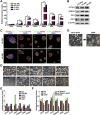Naïve Induced Pluripotent Stem Cells Generated From β-Thalassemia Fibroblasts Allow Efficient Gene Correction With CRISPR/Cas9
- PMID: 26676643
- PMCID: PMC4704878
- DOI: 10.5966/sctm.2015-0157
Naïve Induced Pluripotent Stem Cells Generated From β-Thalassemia Fibroblasts Allow Efficient Gene Correction With CRISPR/Cas9
Erratum in
-
Naïve Induced Pluripotent Stem Cells Generated From β-Thalassemia Fibroblasts Allow Efficient Gene Correction With CRISPR/Cas9.Stem Cells Transl Med. 2016 Feb;5(2):267. doi: 10.5966/sctm.2015-0157erratum. Stem Cells Transl Med. 2016. PMID: 26819338 Free PMC article. No abstract available.
Abstract
Conventional primed human embryonic stem cells and induced pluripotent stem cells (iPSCs) exhibit molecular and biological characteristics distinct from pluripotent stem cells in the naïve state. Although naïve pluripotent stem cells show much higher levels of self-renewal ability and multidifferentiation capacity, it is unknown whether naïve iPSCs can be generated directly from patient somatic cells and will be superior to primed iPSCs. In the present study, we used an established 5i/L/FA system to directly reprogram fibroblasts of a patient with β-thalassemia into transgene-free naïve iPSCs with molecular signatures of ground-state pluripotency. Furthermore, these naïve iPSCs can efficiently produce cross-species chimeras. Importantly, using the clustered regularly interspaced short palindromic repeats (CRISPR)/CRISPR-associated protein 9 nuclease genome editing system, these naïve iPSCs exhibit significantly improved gene-correction efficiencies compared with the corresponding primed iPSCs. Furthermore, human naïve iPSCs could be directly generated from noninvasively collected urinary cells, which are easily acquired and thus represent an excellent cell resource for further clinical trials. Therefore, our findings demonstrate the feasibility and superiority of using patient-specific iPSCs in the naïve state for disease modeling, gene editing, and future clinical therapy.
Significance: In the present study, transgene-free naïve induced pluripotent stem cells (iPSCs) directly converted from the fibroblasts of a patient with β-thalassemia in a defined culture system were generated. These naïve iPSCs, which show ground-state pluripotency, exhibited significantly improved single-cell cloning ability, recovery capacity, and gene-targeting efficiency compared with conventional primed iPSCs. These results provide an improved strategy for personalized treatment of genetic diseases such as β-thalassemia.
Keywords: CRISPR/Cas9; Gene correction; Naïve state; Reprogramming; β-Thalassemia patient.
©AlphaMed Press.
Figures






Comment in
-
Ground state naïve pluripotent stem cells and CRISPR/Cas9 gene correction for β-thalassemia.Stem Cell Investig. 2016 Oct 25;3:66. doi: 10.21037/sci.2016.09.21. eCollection 2016. Stem Cell Investig. 2016. PMID: 27868048 Free PMC article. No abstract available.
-
Efficient CRISPR/Cas9-based gene correction in induced pluripotent stem cells established from fibroblasts of patients with sickle cell disease.Stem Cell Investig. 2016 Nov 14;3:78. doi: 10.21037/sci.2016.11.05. eCollection 2016. Stem Cell Investig. 2016. PMID: 28066780 Free PMC article. No abstract available.
References
-
- Cowan CA, Klimanskaya I, McMahon J, et al. Derivation of embryonic stem-cell lines from human blastocysts. N Engl J Med. 2004;350:1353–1356. - PubMed
-
- Suss-Toby E, Gerecht-Nir S, Amit M, et al. Derivation of a diploid human embryonic stem cell line from a mononuclear zygote. Hum Reprod. 2004;19:670–675. - PubMed
-
- Takahashi K, Tanabe K, Ohnuki M, et al. Induction of pluripotent stem cells from adult human fibroblasts by defined factors. Cell. 2007;131:861–872. - PubMed
-
- Yu J, Vodyanik MA, Smuga-Otto K, et al. Induced pluripotent stem cell lines derived from human somatic cells. Science. 2007;318:1917–1920. - PubMed
-
- Brons IG, Smithers LE, Trotter MW, et al. Derivation of pluripotent epiblast stem cells from mammalian embryos. Nature. 2007;448:191–195. - PubMed
Publication types
MeSH terms
LinkOut - more resources
Full Text Sources
Other Literature Sources
Medical
Molecular Biology Databases

